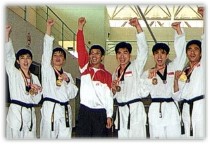Singapore Taekwondo Federation
Taekwondo

Taekwondo is the fastest growing sport in the world. It is popular not only in Singapore but throughout the world.
The sport has been featured as a demonstration sport in two Olympics - Seoul (1988) and Barcelona (1992). It was part of the medal programme of the 2000 Sydney Olympics, the 2004 Athens Olympics and the 2008 Beijing Olympics. If there is no change of plan, taekwondo will be in the medal progr)amme again in the 2012 London Olympics.
However, there is more to taekwondo than sport. It is also a martial art and a form of physical exercise. The multi-disciplinary curriculum includes unarmed combat, taekwon aerobics and 'poomsae' (dance-like movements).

The attraction of taekwondo could be attributed to the opportunities available for the development of physical and mental fitness, the cultivation of desirable values such as tolerance, self-discipline and respect and the learning of effective self-defence techniques.
While anybody, regardless of age, can benefit from the sport, it is particularly beneficial to youths, especially as a positive outlet for their boundless energies.
1. Martial Art

Taekwondo demonstrations are always full of spectacular feats like the breaking of a stack of thirty roofing tiles with the forefist, the splitting of four pieces of thick board with an aerial kick or the smashing of a piece of tile placed eight to ten feet above the ground with the foot. Although such fantastic and flamboyant displays are necessary to show the dynamic power, the flexibility and the prolific nature of taekwondo, these exhibitions have often given spectators the misconception of the essence of the art.

From their observation, taekwondo is merely a physical art of self-defence with lethal techniques for destruction. In fact, taekwondo is more than a physical art. It is also a spiritual art which entails the moral principles of life. Taekwondo has been developed, scientifically systematised and perfected by masters to experts for over twenty centuries in Korea.

'Tae' means to kick or smash with the feet, 'Kwon' implies punching or destroying with the hands or fists and 'Do' means the art or the way. Hence, taekwondo, a Korean phraseology, literally means the art of foot and hand fighting, 'The way' indicates not only the physical but also the spiritual aspect of this form of martial art.
In reality, greater emphasis is placed on the spiritual rather than the physical matters of the art. The ultimate purpose of taekwondo, the true martial art, is the development of healthy bodies and virtues of modesty, benevolence, valour, wisdom, justice, courtesy and perserverance. Therefore, the true taekwondo enables the realisation of the full potential of man, both spiritual and physical.
Taekwondo, thus, the A WAY OF LIFE.
2. Sport

Taekwondo
has evolved into a modern sport while still maintaining the virtues and
practices of the art and the efficient self-defence techniques. As a
sport, it involves the utilisation of the skill of two superbly
co-ordinated and conditioned contestants attempting to score points
through skillful maneuvering, adept foot work and a series of kicks and
punches.
The sport is governed by a set of rules and regulations designed by the World Taekwondo Federation. Amongst other things, the aim of the rules and regulations is to eliminate injurious techniques. The safety aspect is further enforced by the mandatory use of head gear, body protector, groin guard, shin guard and forearm guard.
Taekwondo is a wonderful sport as it provides the opportunity for participants to channel their aggressive tendencies through such a constructive activity governed by a set of rules and a spirit of fair play. It enables them to build and maintain a strong body through vigorous muscle exercise and also develop confidence, courage, self-reliance, quick thinking and respect for one's fellow man.
Another outstanding feature of the sport is the provision of a practical experience for participants to stand alone and face a series of difficult problems that call for split second decisions.

